StarTech Standalone Hard Drive Eraser And USB 3.0 Dock Capsule Review
by Billy Tallis on February 16, 2016 8:00 AM EST- Posted in
- Storage
- USB 3.0
- SATA
- DAS
- StarTech.com
Sequential Read Performance
The sequential read test requests blocks of 128kB and tests queue depths ranging from 1 to 32, with the queue depth doubled every three minutes for a total test duration of 18 minutes. The primary score we report is an average of the lower queue depths that are most common in client usage scenarios. We also graph how performance scales across queue depths.

The hard drive's sequential read performance is slightly lower in the dock than when connected internally, but the SSDs is slowed down to below the hard drive's speed.
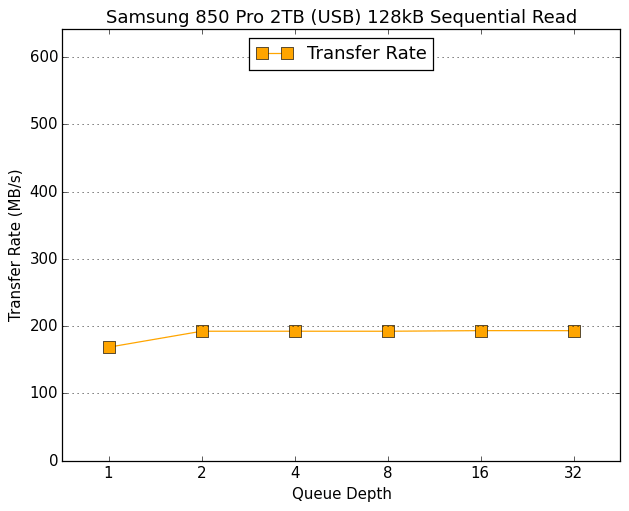 |
|||||||||
| Samsung 850 Pro 2TB (SATA) | Samsung 850 Pro 2TB (USB) | ||||||||
| Seagate Barracuda 3TB (SATA) | Seagate Barracuda 3TB (USB) | ||||||||
Both the SSD and hard drive show slightly lower QD1 performance in the dock than the very steady performance at all higher queue depths. This suggests there's a bit of command processing latency in the dock that can be masked by queuing up requests, but it's unclear why the SSDs sequential read performance ends up lower than the hard drive's.
Sequential Write Performance
The sequential write test follows the same timing and queue depth schedule as the sequential read test, and is scored the same.
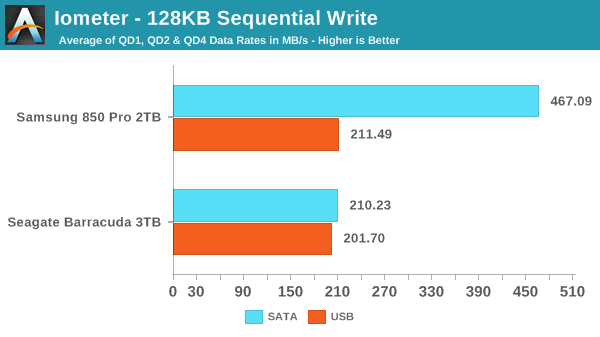
Sequential write performance is very similar to sequential read for the hard drive, with slight overhead due to the dock. The SSD manages to beat the hard drive when docked this time, but is still severely restricted by the slower interfaces.
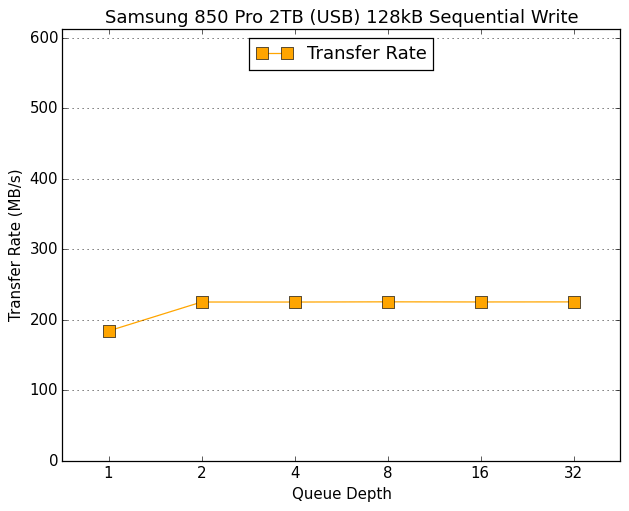 |
|||||||||
| Samsung 850 Pro 2TB (SATA) | Samsung 850 Pro 2TB (USB) | ||||||||
| Seagate Barracuda 3TB (SATA) | Seagate Barracuda 3TB (USB) | ||||||||
Again QD1 performance is slightly lower for both drives in the dock and the dock is only able to keep pace with the mechanical drive, but there are no other surprises from it on this test.
Mixed Sequential Read/Write Performance
The mixed sequential access test covers the entire span of the drive and uses a queue depth of one. It starts with a pure read test and gradually increases the proprotion of writes, finishing with pure writes. Each subtest lasts for 3 minutes, for a total test duration of 18 minutes.
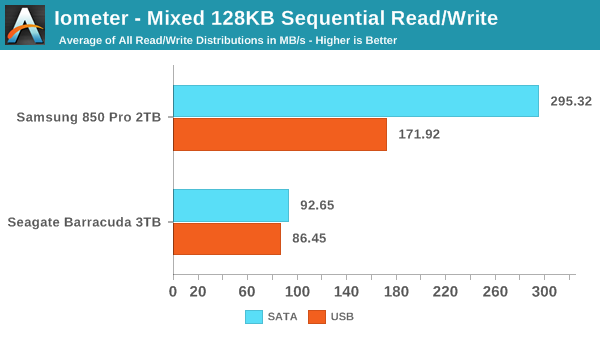
The mixed sequential test is the best showing from the dock. SSDs usually perform much worse on mixed sequential workloads than on pure read or write sequential access, so the dock's performance limits don't look as bad in this light. The hard drive's mixed sequential performance is also much worse than for pure reads or writes, and the dock's overhead is minor.
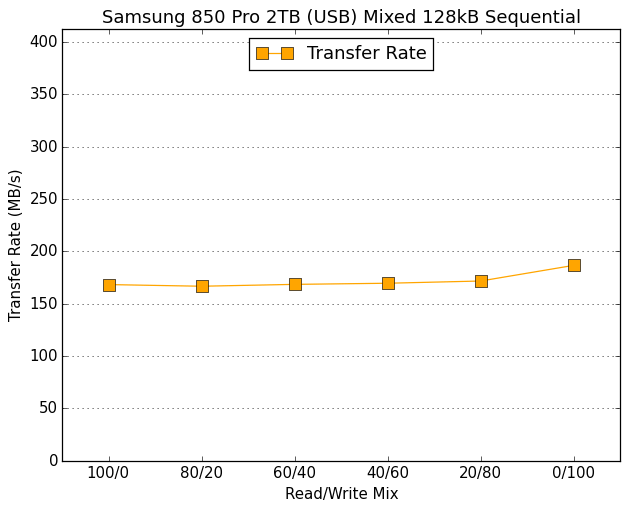 |
|||||||||
| Samsung 850 Pro 2TB (SATA) | Samsung 850 Pro 2TB (USB) | ||||||||
| Seagate Barracuda 3TB (SATA) | Seagate Barracuda 3TB (USB) | ||||||||
The dock limits the SSD to mostly-uniform performance across the mixed sequential test that is all well below what the drive can do with an internal 6Gbps SATA connection. For the hard drive, the only significant differences are moderate performance penalties on the pure-read and pure-write portions of the test.










38 Comments
View All Comments
Samus - Wednesday, February 17, 2016 - link
Interesting product, but really expensive. You could build a great drive wiping station for $100 bucks, one that could wipe 4+ drives simultaneously. All you need is a semi-modern motherboard with a few SATA ports, a USB flash drive to boot Derik's Boot and Nuke, and a cozy case lined with rubber to set the drives on or a case with tool-less drive insert/ejection. Boot and Nuke can be scripted to run autonomously so you wouldn't need a keyboard/mouse/monitor, just turn the PC on with drives attached, wait for the flash drive access light to stop blinking and press 1-5 to run scripts 1-5 which you define. It can output a log to serial\parallel port, or write a recurring log to a network share or the USB flash drive itself. I setup a station years ago that printed a report to a networked printer by just outputting the log to an IP address, and the printer would pick it up as a PCL job,This is just 3x more expensive than it should be. If it did 2-4 drives simultaneously, had eSATA, working USB 3.0 UASP, more custom configurations/scripting and perhaps a built in thermal label printer, $300 would be justified. But as it is, it's just a glorified (and crippled) $30 drive dock.
erple2 - Sunday, February 28, 2016 - link
I'm not sure that Darik's boot and nuke is sufficient, though. Most hard drives (all hard drives made after about 2001) implement the ata secure erase feature in firmware (it's part of the ata spec). So a simple hdparm command will do what you need to securely erase any HDD. Note that the "overwrite n times with alternating 0's and 1's" method isn't really any more helpful today as it was in the past. Even a single full overwrite buys you only a barely better than 50% chance of getting the value of the given bit. Plus with the density of data HDDs today, it's very nearly impossible to even read a drive without its read head.As for SSD, that's probably more complex, but the "sanitize" command should be sufficient. It passes nist sp800-88, at least.
azrael- - Thursday, February 18, 2016 - link
I see a Seagate HDD was used in the test. Don't Seagate drives have a history of destroying themselves (albeit at usually the most inopportune time) making this a moot exercise... ;-)Senti - Friday, February 19, 2016 - link
Seagate drive is another insurance that data is really destroyed.scaryhalo - Saturday, February 20, 2016 - link
Coffee and Doughnut on screen, large grin on face, strange look from fellow commuters! You sir, are chuckle master today :)Reginaldpeebottom - Thursday, February 18, 2016 - link
I think the market they are seeking to fill is obviously a niche one and the price is appropriate. All the suggestions here of it being cheaper to setup something that could do more drives, or faster, or "better" somehow miss the point that this product is aimed at something like a small-medium sized professional/business office (Doctor, lawyer, accountant, etc) where they don't have a permanent IT person, they have staff with computer skills which are minimal beyond their work applications, and they need or are required to deal with privacy related issues upon decommissioning old computer HDs. This product is perfect for that: it looks simple to use, is stand alone, and time really isn't an issue since th staff person just walks away and does her/his work. The print out is great too if used as a way to have a record of the job being done for auditing purposes. $300 price tag is something businesses like that won't even blink at. It's not that expensive and it can be expensed.bobbozzo - Sunday, February 21, 2016 - link
Hi, I would have liked to see a few words about build quality...I was looking for an eSATA dual-dock, and came across StarTech and some other brands, but all of them had lots of bad reviews complaining about unreliable connections, etc.
thanks!
Sam Snead - Saturday, March 12, 2016 - link
If you really wanted to make sure no one could ever read a drive, wouldn't it be better to drill a few holes through the drive and toss it into the nearest body of water? I've heard a few .45 caliber slugs thru the drive also makes it unreadable, but that is awfully non-PC.